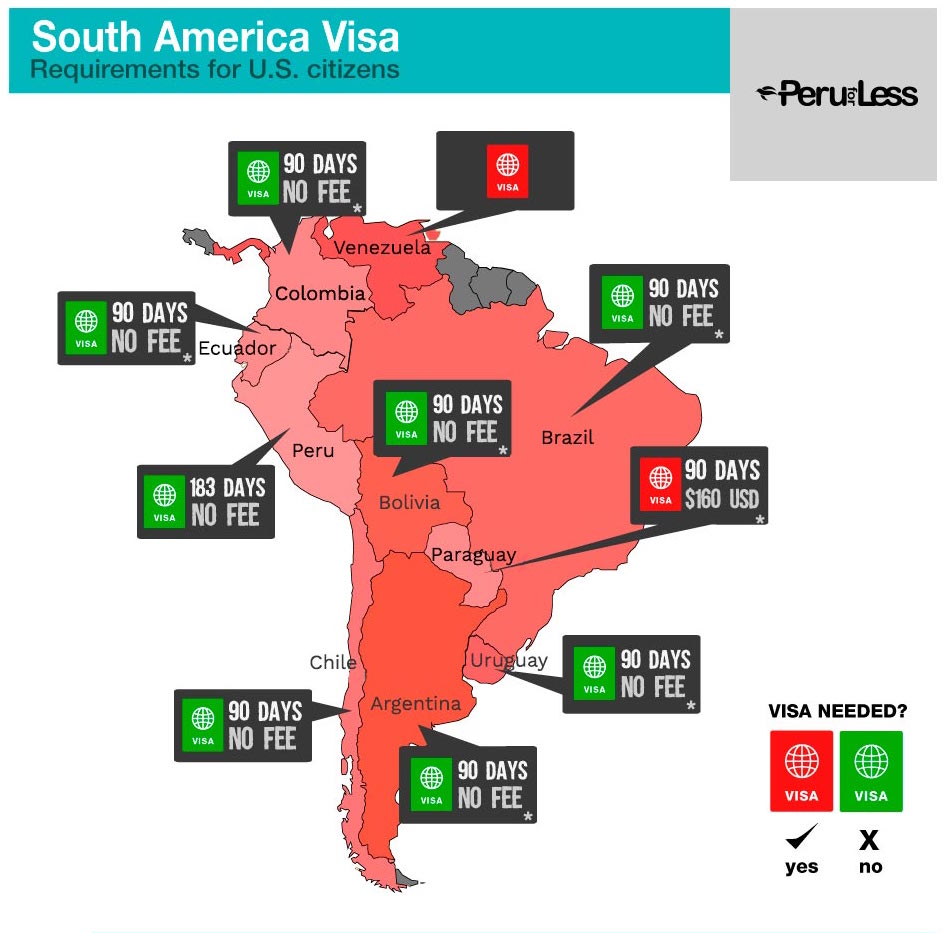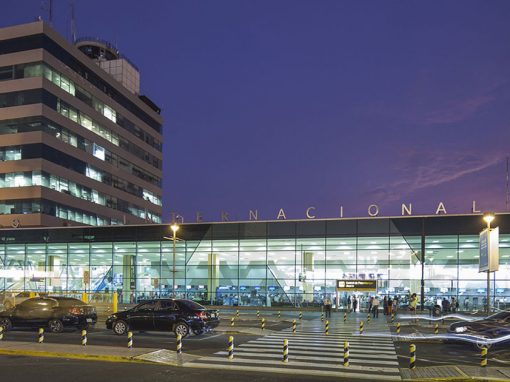Avoid delays and denied entries: make sure that you are in-the-know about South American travel requirements prior to departure. We’ve detailed the South America visa requirements and any associated fees (sometimes called reciprocity tax) for travel in South America, with special attention to our featured destinations: Argentina, Brazil, Chile, Ecuador, and Peru.
Content
Overview
South America Visa Requirements for U.S. Citizens
Argentina | Brazil | Chile | Ecuador (Galapagos) | Peru
This article was updated on April 28, 2021.
Overview
- Most South American countries require that your passport is valid at least 6 months from the time of travel.
- Make sure your passport has free pages available for stamps.
- Many travelers coming to South America don’t have to apply for a tourist visa in advance. However, this depends on your nationality, so if you have any questions or doubts, ask your Travel Advisor.
- Good news: Argentina, Chile, Brazil, and Bolivia no longer impose a reciprocity tax for many nationalities, including U.S. citizens.
- Carry proof of onward or return travel, like a plane ticket. Sometimes immigration officers ask for it.
- Always carry a copy of your passport, throughout your travels.
- Some countries require that you pay a departure tax – make sure to budget this!
South America Visa Requirements for U.S. Citizens
Many countries in South America have lifted fees, sometimes called reciprocity tax, for U.S. citizens. The following graphic showcases what countries require a visa and how many days American tourists are usually permitted to stay.

Read more about traveling to Uruguay as a U.S. citizen. Entry into Venezuela is very limited and updated information is outlined in this U.S. Department of State travel page.
Update for Bolivia: As of December 2019, U.S. citizens no longer need to pay the $160 USD reciprocity fee to obtain a visa to enter Bolivia for tourism. Now, entry is granted at the discretion of the Bolivian immigration officer for 30, 60, or 90 days.
Update for Brazil: As of June 2019, U.S. citizens do not need a visa to travel to Brazil for tourism. As such, there is no longer a $160 USD fee to enter the country.
Update for Argentina: Effective August 2016, citizens of the United States are exempt from paying a reciprocity fee to enter Argentina for tourism purposes. The $160 USD reciprocity is no longer paid by Americans.
Argentina
Citizens of many countries do not need to apply for a tourist visa to travel to Argentina. Click here for a complete list.
To enter Argentina, you must have a passport that’s valid for at least 6 months after their arrival date. The stamp in your passport serves as your tourist visa and indicates how long you can stay in the country.
Depending on your nationality, you may be charged a reciprocity tax that needs to be paid before your arrival.
Argentina Reciprocity Fee Updates:
- Citizens of Australia, Canada, and the United States no longer need to pay the reciprocity tax.
- Chinese citizens do need to pay the reciprocity fee. Their issued tourist visa is valid for multiple entries for one year from the date of the first entry.
How to pay the reciprocity fee for Argentina:
Payment for the reciprocity fee (if it applies to your nationality) must be submitted and completed online before arrival. Visit Argentina’s government immigration website to access a secure transaction system.
Brazil
Many countries are exempt from pre-departure visa requirements in Brazil, and as of 2019, citizens of the United States, Canada, and Australia are no longer required to apply in advance and pay the fee to acquire a tourist visa.
However, citizens of China, India, and Russia, among others, are still required to apply for a tourist visa.
A passport that’s valid for six months after the entry date to Brazil is required for all travelers. The stamp in your passport indicates how long you can stay in Brazil as a tourist. Usually, a tourist in Brazil can stay up to 90 days per year with a chance to extended up to 180 days.
Chile
The reciprocity fee for Chile has been lifted for Australia, Canada, and the United States. Now citizens from these countries, and many others, don’t need to worry about any online payments to get a tourist visa in advance. Instead, upon arrival, an immigration officer stamps your passport which indicates how long they can stay in Chile as a tourist, usually for up to 90 days. It’s possible to extend your stay in Chile for another 90 days (total of 180) by making a $100 USD payment at a Chilean Immigration Office or at the airport
When entering Chile, you need to present a valid passport and fill out a Tourist Card. Be careful not to misplace this card (keep it with your passport) because you will need to return it to customs when leaving the country.
For flights leaving from Santiago, each passenger is required to pay a departure tax around $25 USD for international flights. Please note that other airports in Chile may have different departure tax rates and policies.
Ecuador
Many nationalities, including Australians, Americans, Canadians, and many Europeans, do not need a tourist visa to be granted access to Ecuador. Additional fees and taxes, however, do apply for flights to the Galapagos Islands and entry into the national park.
Upon arrival in Ecuador, you must:
- Present a valid passport at the immigration control (expiration date no less than 6 months after travel dates)
- Might be asked to present proof of onward/return travel (i.e. flight itinerary)
Visitors are issued a tourist visa upon arrival at the airport. The visa allows tourists to stay in Ecuador for a total of up to 90 days. An additional 90-day extension can be requested.
There’s an exit fee for international flights leaving mainland Ecuador. This airport tax ranges between $30 and $40 USD, depending on if you fly out of Guayaquil or Quito. This tax, however, is usually included in the price of your flight.
If you plan to visit the Galapagos Islands, you will have to obtain an INGALA Transit Control Card which enables the government of Ecuador to control immigration to the Galapagos. The cost per transit card is U$10 each way (or $20 roundtrip) per traveler and is paid at the INGALA window in the domestic terminal at the Quito or Guayaquil airports. Keep your transit card in a safe place with your passport because you’ll need both to get on the plane to the Galapagos and then again at the end of your trip. Upon arrival to the Galapagos, you must pay the $100 USD national park fee in cash at the airport in the archipelago.
For details regarding Ecuador travel restrictions, entry requirements, and government protocols check out our Covid-19 in Ecuador blog post.
Peru
With few exceptions, many travelers do not need to apply for a tourist visa to enter Peru.
Access to Peru is granted upon arrival by a Peruvian immigration officer who stamps your passport with the number of days you can stay in the country for travel purposes. Tourists are given up to 90 days, although it is possible to ask for up to 183. The expiration date of your passport must be valid for at least six months after the date of your arrival to Peru and you might be asked for proof of onward/return travel (i.e. your flight itinerary).
During your stay in Peru, you need to show your passport when you check-in at hotels so staff can confirm with government records that you are a tourist and exempt from paying the country’s 18% sales tax on your lodging. Please note that if you stay as a tourist in Peru for more than 59 days then you have to pay the sales tax.
For details regarding Peru travel restrictions, entry requirements, and government protocols check out our Coronavirus in Peru blog.
There are several details to cover when you’re planning a trip to South America. For starters, there are visa requirements (if any) to check, and then all the transport logistics, lodging, and tours. For help planning your upcoming trip, contact us and get in touch with an expert Travel Advisor at Peru For Less!

Hendrika is Belgian but she considers herself a citizen of the world as she has lived in many different countries before moving to Peru. She fell in love with South America after her first visit to the continent in Bolivia, and has since then spent a lot of time traveling in the area. She especially enjoys Peru for its diversity, delicious food, and rich history.








